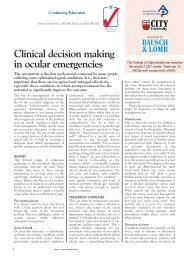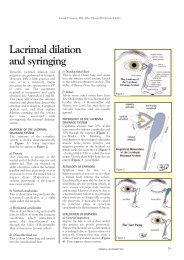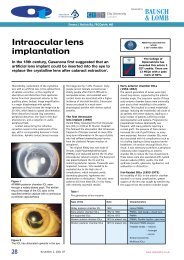Create successful ePaper yourself
Turn your PDF publications into a flip-book with our unique Google optimized e-Paper software.
CONTINUING EDUCATION AND TRAINING<br />
Gain 2 CET credits - enter online at www.otcet.co.uk or by post<br />
for RGP materials compared to PMMA.<br />
For <strong>the</strong> same reason, <strong>the</strong>re may be more<br />
surface/tarsal plate interaction with RGP<br />
compared to PMMA. Fur<strong>the</strong>rmore, <strong>the</strong> visual<br />
performance in terms of visual acuity,<br />
contrast and reduction of distortions or<br />
ghosting is reduced when <strong>the</strong>re is a visual<br />
axis contact zone.<br />
Impression ventilated PMMA proved to<br />
be a successful option in many cases before<br />
RGP materials were available. A ventilated<br />
impression PMMA lens is easier to produce<br />
than RGP due to its superior <strong>the</strong>rmoplasticity,<br />
and because it can be cut and polished<br />
with minimum risk of irreparable damage.<br />
Impression ventilated ScCLs very often have<br />
central corneal contact zones after settling<br />
back, irrespective of <strong>the</strong> material. If so, PMMA<br />
is more likely to be tolerated. Impression<br />
PMMA is arguably <strong>the</strong> method of choice for<br />
elderly aphakes. Centration is optimised with<br />
<strong>the</strong> impression method of fitting as <strong>the</strong>re is a<br />
near glove fit on <strong>the</strong> sclera. Thus <strong>the</strong> front<br />
optic can be sited over <strong>the</strong> visual axis to<br />
minimise aberrations.<br />
Preformed fenestrated PMMA may be<br />
a preferable option to RGP fenestrated<br />
because it may be fitted with less initial<br />
clearance so that apical contact following<br />
any settling on <strong>the</strong> globe is better tolerated<br />
than if an RGP lens is similarly fitted.<br />
However, <strong>the</strong> chances of a successful outcome<br />
with a moderately or advanced ectasia<br />
and irregular topography remain limited<br />
for <strong>the</strong> reasons discussed previously.<br />
Impression or preformed nonventilated<br />
PMMA has no place for long<br />
term wear as <strong>the</strong> onset of hypoxia is very<br />
rapid. However, it is worth remembering that<br />
advanced keratoconus causes extremely poor<br />
unaided vision and spectacles may do next to<br />
nothing by way of correction.<br />
Therefore, all contact lens options should<br />
be borne in mind. If good vision to deal with<br />
a particular task is urgently required for a<br />
few minutes, a non-ventilated PMMA lens<br />
provides just that.<br />
The fitting and production are <strong>the</strong> simplest<br />
for all scleral lens types provided <strong>the</strong><br />
scleral zone seals adequately on <strong>the</strong> sclera,<br />
which should be <strong>the</strong> case following an<br />
impression lens if not with a preformed lens.<br />
Preformed non-ventilated RGP<br />
ScCL fitting<br />
PMMA ScCLs, whe<strong>the</strong>r preformed or<br />
impression of preformed, are comparatively<br />
infrequently required nowadays. The fitting<br />
Figure 3 Optimum preformed lens fitting with scleral alignment and optic zone clearance<br />
Figure 4 Steep fitting scleral zone<br />
illustrating fluorescein encroaching almost<br />
to <strong>the</strong> periphery of <strong>the</strong> lens. There is also a<br />
small amount of blanching at <strong>the</strong> edge<br />
Figure 5 Flat fitting scleral zone on <strong>the</strong><br />
same eye as seen in Figure 4. The<br />
fluorescein is only seen just beyond <strong>the</strong><br />
limbus, and <strong>the</strong>re is obvious blanching in<br />
<strong>the</strong> mid-periphery<br />
systems for both have been well documented<br />
in previous textbooks and summarised<br />
recently 19 , so it is not appropriate to expand<br />
fur<strong>the</strong>r on <strong>the</strong> preceding discussion which<br />
outlines <strong>the</strong>ir role.<br />
However, <strong>the</strong> fitting processes for RGP<br />
ScCLs have been more recently developed,<br />
hence <strong>the</strong> principles are outlined in <strong>the</strong> following<br />
text.<br />
Lens diameter<br />
The diameter is chosen according to <strong>the</strong><br />
appearance at <strong>the</strong> assessment and fitting<br />
process, and can be between 16mm and<br />
25mm. In fact, 18mm to 23mm is a more<br />
usual range for preformed lenses. Indeed,<br />
16mm is very small for a lens to be defined<br />
as a ScCL, that is, having a scleral bearing<br />
surface and essentially with corneal clearance.<br />
If <strong>the</strong> corneal diameter is taken to be<br />
12mm, and it is deemed desirable to allow<br />
an extra 1mm all round for limbal clearance,<br />
a 16mm total diameter only allows a 1mm<br />
scleral bearing annulus. The author<br />
acknowledges <strong>the</strong> valuable role for lenses<br />
with a diameter smaller than 16mm, but<br />
<strong>the</strong>y do not conform to this definition of a<br />
ScCL and are fitted according to a different<br />
rationale.<br />
A small variation in <strong>the</strong> diameter may not<br />
make much difference, but if a lens were to<br />
be made progressively smaller <strong>the</strong> original<br />
bearing surface would eventually be eliminated.<br />
The new bearing surface would <strong>the</strong>n<br />
be <strong>the</strong> sector of <strong>the</strong> sclera which was previously<br />
<strong>the</strong> transition zone with <strong>the</strong> larger<br />
diameter lens. The result is likely to be<br />
29 | October 20 | 2006 | OT
















